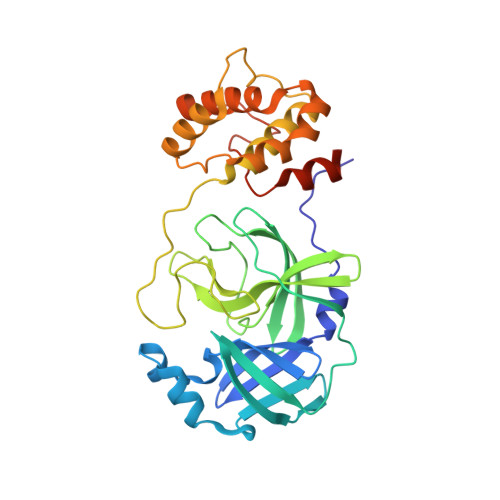Mechanism for controlling the monomer-dimer conversion of SARS coronavirus main protease.
Wu, C.G., Cheng, S.C., Chen, S.C., Li, J.Y., Fang, Y.H., Chen, Y.H., Chou, C.Y.(2013) Acta Crystallogr D Biol Crystallogr 69: 747-755
- PubMed: 23633583
- DOI: https://doi.org/10.1107/S0907444913001315
- Primary Citation of Related Structures:
4HI3 - PubMed Abstract:
The Severe acute respiratory syndrome coronavirus (SARS-CoV) main protease (M(pro)) cleaves two virion polyproteins (pp1a and pp1ab); this essential process represents an attractive target for the development of anti-SARS drugs. The functional unit of M(pro) is a homodimer and each subunit contains a His41/Cys145 catalytic dyad. Large amounts of biochemical and structural information are available on M(pro); nevertheless, the mechanism by which monomeric M(pro) is converted into a dimer during maturation still remains poorly understood. Previous studies have suggested that a C-terminal residue, Arg298, interacts with Ser123 of the other monomer in the dimer, and mutation of Arg298 results in a monomeric structure with a collapsed substrate-binding pocket. Interestingly, the R298A mutant of M(pro) shows a reversible substrate-induced dimerization that is essential for catalysis. Here, the conformational change that occurs during substrate-induced dimerization is delineated by X-ray crystallography. A dimer with a mutual orientation of the monomers that differs from that of the wild-type protease is present in the asymmetric unit. The presence of a complete substrate-binding pocket and oxyanion hole in both protomers suggests that they are both catalytically active, while the two domain IIIs show minor reorganization. This structural information offers valuable insights into the molecular mechanism associated with substrate-induced dimerization and has important implications with respect to the maturation of the enzyme.
Organizational Affiliation:
Department of Life Sciences and Institute of Genome Sciences, National Yang-Ming University, Taipei 112, Taiwan.














